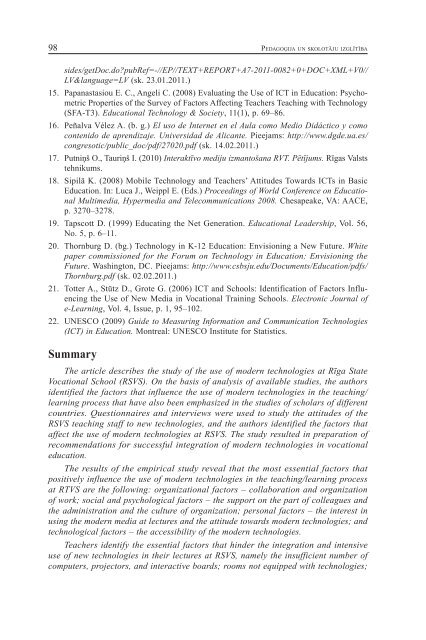Create successful ePaper yourself
Turn your PDF publications into a flip-book with our unique Google optimized e-Paper software.
98 Pe d a g o ģ i j a un s k o l o t ā j u i z g l ī t ī b a<br />
sides/getDoc.do?pubRef=-//EP//TEXT+REPORT+A7-2011-0082+0+DOC+XML+V0//<br />
LV&language=LV (sk. 23.0<strong>1.</strong>201<strong>1.</strong>)<br />
15. Papanastasiou E. C., Angeli C. (2008) Evaluating the Use of ICT in Education: Psychometric<br />
Properties of the Survey of Factors Affecting Teachers Teaching with Technology<br />
(SFA-T3). Educational Technology & Society, 11(1), p. 69–86.<br />
16. Peñalva Vélez A. (b. g.) El uso de Internet en el Aula como Medio Didáctico y como<br />
contenido de aprendizaje. Universidad de Alicante. Pieejams: http://www.dgde.ua.es/<br />
congresotic/public_doc/pdf/27020.pdf (sk. 14.02.201<strong>1.</strong>)<br />
17. Putniņš o., Tauriņš I. (2010) Interaktīvo mediju izmantošana RVT. Pētījums. Rīgas Valsts<br />
tehnikums.<br />
18. Sipilä K. (2008) Mobile Technology and Teachers’ Attitudes Towards ICTs in Basic<br />
Education. In: Luca J., Weippl E. (Eds.) Proceedings of World Conference on Educational<br />
Multimedia, Hypermedia and Telecommunications 2008. Chesapeake, VA: AACE,<br />
p. 3270–3278.<br />
19. Tapscott D. (1999) Educating the Net generation. Educational Leadership, Vol. 56,<br />
No. 5, p. 6–1<strong>1.</strong><br />
20. Thornburg D. (bg.) Technology in K-12 Education: Envisioning a New Future. White<br />
paper commissioned for the Forum on Technology in Education: Envisioning the<br />
Future. Washington, DC. Pieejams: http://www.csbsju.edu/Documents/Education/pdfs/<br />
Thornburg.pdf (sk. 02.02.201<strong>1.</strong>)<br />
2<strong>1.</strong> Totter A., Stütz D., grote g. (2006) ICT and Schools: Identification of Factors Influencing<br />
the Use of New Media in Vocational Training Schools. Electronic Journal of<br />
e-Learning, Vol. 4, Issue, p. 1, 95–102.<br />
22. UNESCo (2009) Guide to Measuring Information and Communication Technologies<br />
(ICT) in Education. Montreal: UNESCo Institute for Statistics.<br />
Summary<br />
The article describes the study of the use of modern technologies at Rīga State<br />
Vocational School (RSVS). On the basis of analysis of available studies, the authors<br />
identified the factors that influence the use of modern technologies in the teaching/<br />
learning process that have also been emphasized in the studies of scholars of different<br />
countries. Questionnaires and interviews were used to study the attitudes of the<br />
RSVS teaching staff to new technologies, and the authors identified the factors that<br />
affect the use of modern technologies at RSVS. The study resulted in preparation of<br />
recommendations for successful integration of modern technologies in vocational<br />
education.<br />
The results of the empirical study reveal that the most essential factors that<br />
positively influence the use of modern technologies in the teaching/learning process<br />
at RTVS are the following: organizational factors – collaboration and organization<br />
of work; social and psychological factors – the support on the part of colleagues and<br />
the administration and the culture of organization; personal factors – the interest in<br />
using the modern media at lectures and the attitude towards modern technologies; and<br />
technological factors – the accessibility of the modern technologies.<br />
Teachers identify the essential factors that hinder the integration and intensive<br />
use of new technologies in their lectures at RSVS, namely the insufficient number of<br />
computers, projectors, and interactive boards; rooms not equipped with technologies;

















